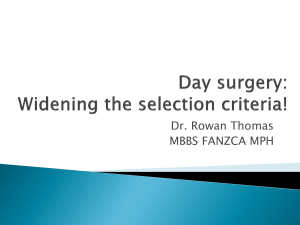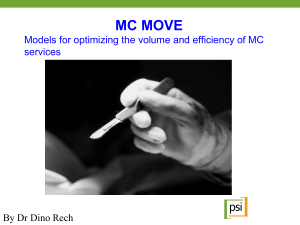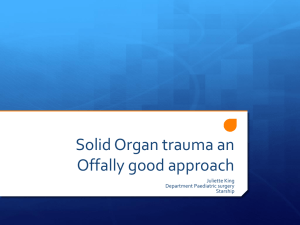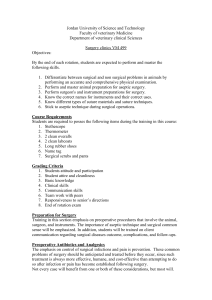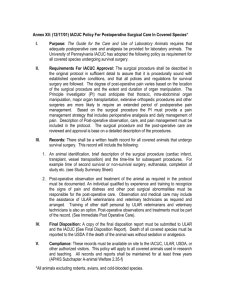Pediatric Surgery Goals and Objectives
advertisement
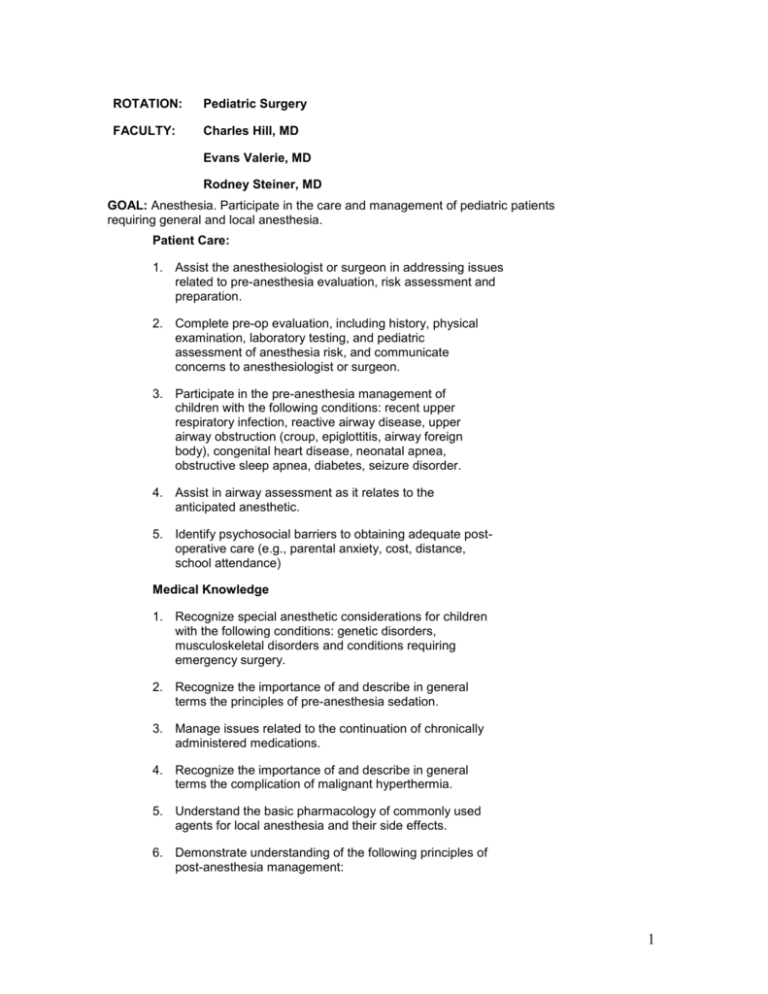
ROTATION: Pediatric Surgery FACULTY: Charles Hill, MD Evans Valerie, MD Rodney Steiner, MD GOAL: Anesthesia. Participate in the care and management of pediatric patients requiring general and local anesthesia. Patient Care: 1. Assist the anesthesiologist or surgeon in addressing issues related to pre-anesthesia evaluation, risk assessment and preparation. 2. Complete pre-op evaluation, including history, physical examination, laboratory testing, and pediatric assessment of anesthesia risk, and communicate concerns to anesthesiologist or surgeon. 3. Participate in the pre-anesthesia management of children with the following conditions: recent upper respiratory infection, reactive airway disease, upper airway obstruction (croup, epiglottitis, airway foreign body), congenital heart disease, neonatal apnea, obstructive sleep apnea, diabetes, seizure disorder. 4. Assist in airway assessment as it relates to the anticipated anesthetic. 5. Identify psychosocial barriers to obtaining adequate postoperative care (e.g., parental anxiety, cost, distance, school attendance) Medical Knowledge 1. Recognize special anesthetic considerations for children with the following conditions: genetic disorders, musculoskeletal disorders and conditions requiring emergency surgery. 2. Recognize the importance of and describe in general terms the principles of pre-anesthesia sedation. 3. Manage issues related to the continuation of chronically administered medications. 4. Recognize the importance of and describe in general terms the complication of malignant hyperthermia. 5. Understand the basic pharmacology of commonly used agents for local anesthesia and their side effects. 6. Demonstrate understanding of the following principles of post-anesthesia management: 1 a) Management of post-anesthesia nausea and vomiting b) Post-surgical pain management (in-hospital, day surgery, home) c) Re-establishment of PO intake after anesthesia d) Discharge criteria e) Adequate follow-up Intrapersonal and Communication Skills 1. Assist in the psychosocial preparation of the child and parents for anesthesia. 2. Participate in educating families regarding principles related to NPO status and PO intake prior to induction of anesthesia. Systems Based Practice 1. Participate in deciding whether a child is appropriate for day surgery or inpatient surgery. 2. Identify psychosocial barriers to obtaining adequate postoperative care (e.g., parental anxiety, cost, distance, school attendance) 3. Refer for cardiovascular assessment as it relates to the anticipated anesthetic. GOAL: Normal Vs. Abnormal (Surgery). Differentiate normal conditions from pathologic ones requiring surgical intervention. Patient Care and Communication: 1. Counsel parents regarding the natural history of uncomplicated umbilical hernia. Medical Knowledge: 1. Distinguish inguinal hernia from hydrocele and describe when it is appropriate for the pediatrician to observe and follow, and when to refer for evaluation. 2. Distinguish acute abdominal pain related to transient events like constipation, musculoskeletal pain or gastroenteritis from pain that is likely to come from a serious surgical condition. 3. Interpret clinical and laboratory tests to identify conditions that require surgical intervention, including: 2 a) Blood studies (CBC, ESR, Electrolytes, BUN, Creatinine, LFTs, amylase, lipase) b) Occult blood in gastric fluid and stool c) Cultures (blood, stool, wound, urine, fluid from body cavities and abscesses) d) Radiographic studies (KUB and upright abdominal films, barium enema, UGI and small bowel follow through) GOAL: Undifferentiated Signs and Symptoms (Surgery). Evaluate and appropriately treat or refer signs and symptoms that may require surgery. Medical Knowledge: 1. Create a strategy to determine if the following presenting signs and symptoms are caused by a surgical condition, provide initial evaluation or treatment, and refer appropriately: a) Acute abdominal pain b) Acute scrotum c) Vomiting, especially bilious or bloody d) Inguinal swelling or mass e) Abdominal mass f) Bloody stools GOAL: Common Conditions Not Referred (Surgery). Diagnose and manage common conditions that generally do not require surgical referral. Medical Knowledge and Patient Care: 1. Diagnose, manage, and counsel patients and parents about the following conditions that generally do not require surgical evaluation: a) Umbilical hernia b) Retractile testes c) Resolving hydrocele d) Transient lymphadenopathy e) Minor lacerations Conditions Generally Referred (Surgery). Diagnose, provide initial stabilization, and refer appropriately conditions that usually require surgical evaluation. Patient Care: 3 1.Recognize, stabilize and initiate management and surgical referral for the following conditions: Intussusception, tumor, trauma. Burns, failure to thrive, GE reflux requiring surgical intervention, central venous access, lymphadenitis, prenatal diagnosis of surgical conditions, caustic esophageal strictures, pleural effusion, pyloric stenosis, meconium ileus, meckel’s, malrotation/volvulus, short bowl syndrome from NEC, neck masses, imperforate anus, chest wall defects, ambiguous genitalia, GI bleeding, intestinal obstruction, undescended testis, ganglion cysts, IBD, appendicitis, biliary atresia, gall bladder disease and pnacreatitis Systems Based Practice: 1. Identify the role and general scope of practice of pediatric surgeons; recognize situations where children benefit from the skills of surgeons with specialized training in the care of infants and children; and work effectively with these professionals in the care of children's surgical conditions. GOAL: Pre-operative and Post-operative Evaluation (Surgery). Collaborate with surgeons in the pre-operative and post-operative evaluation and management of pediatric patients, differentiating between adult and pediatric surgeons. Patient Care: 1. Evaluate patients pre-operatively to provide medical clearance for surgery. 2. Obtain history of prior surgery and anesthesia. 3. Identify bleeding tendencies. 4. Assess oral cavity for loose teeth if endotracheal intubation is anticipated. 5. Manage any chronic respiratory conditions (e.g., asthma) that may have an impact on surgery and recovery. 6. Participate in the post-operative follow-up of surgical patients. 7. Monitor fluid and electrolyte status. 8. Observe for fever and recognize different causes of fever and their appropriate evaluation. 9. Recognize and manage common post-operative complications (bleeding, stridor, infections, wound dehiscence). 10. Manage post-operative pain. 11. Assess discharge and follow-up plans. 4 12. Recognize psychosocial stresses of surgery on families and anticipate potential barriers to adequate post-op care. Systems Based Practice: 1. Refer patients needing surgical intervention to the appropriate pediatric surgical subspecialist, if available in your locale. 2. Recognize psychosocial stresses of surgery on families and anticipate potential barriers to adequate post-op care. 3. Function as a pediatric consultant to surgical colleagues in the diagnosis and management of pediatric patients. GOAL: Trauma (Surgery). Evaluate, stabilize, manage and refer as necessary patients presenting with trauma. Patient Care: 1. Evaluate patients presenting with simple or multiple trauma by performing a primary and secondary survey. 2. Manage mild trauma (e.g., mild closed head trauma or extremity soft tissue injury). 3. Stabilize and refer patients with multiple trauma. Medical Knowledge: 1. Describe the main differences between a level 1, 2 and 3 trauma center, including specialists available at the site and type of pediatric patients served. Communication: 1. Counsel families regarding strategies to prevent traumatic injuries in childhood. GOAL: Appendicitis. Recognize, diagnose, manage and refer patients with appendicitis. Medical Knowledge: 1. Recognize common and unusual presenting signs and symptoms indicating appendicitis, and diagnose by eliciting the appropriate history and physical examination findings. 2. When the diagnosis is not certain, recognize situations warranting inpatient admission for medical observation and repeated surgical consultation during course of illness. 3. Use imaging studies appropriately in the diagnosis of appendicitis. 4. Obtain laboratory tests suitable for evaluation of appendicitis and 5 also in anticipation of surgical intervention. Patient Care and Communication 1. Discuss potential surgical intervention with patients and families. GOAL: Therapeutic and Technical Procedures (Surgery). Acquire recommended proficiency in the use and performance of common surgical procedures. Patient Care: 1.Order or perform, collect proper specimens, and interpret results or response to the following clinical studies and procedures used in surgery: 1. Incision and drainage of simple abscess, including paronychia; Management of first and second degree burns; Gastric suction and lavage; Placement of gastric tube (orogastric or nasogastric); Gastrostomy tube replacement; Reduction of simple hernia; Central line use and care; Drainage of subungual hematoma; Suture of simple lacerations; Needle thoracentesis; Simple wound care In Addition: Procedures GOAL: Technical and therapeutic procedures. Describe the following procedures, including how they work and when they should be used; competently perform those commonly used by the pediatrician in practice. Abscess: I & D of superficial abscesses; Digital blocks; Burns- acute stabilization; Central line care; Chest tube placement; Foreign body removal; Gastric lavage; OG/NG placement; Inguinal hernia reduction; Sterile technique; Subungual hematoma drainage; Thoracentesis 6


